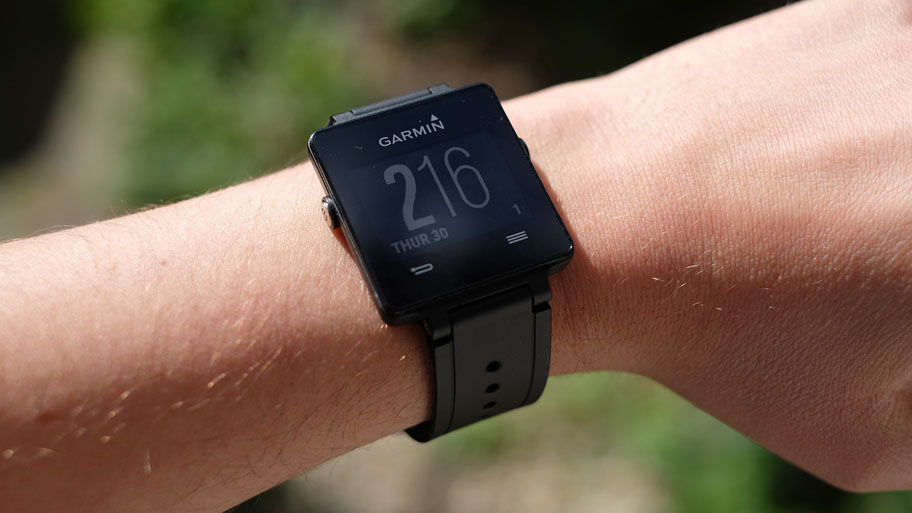Why you can trust TechRadar
But if it lasts this long even when using battery-chomping GPS, how smart can it really be?
The Garmin Vivoactive does not use any of the well-known smartphone platforms, instead sharing software with some of Garmin's top-end sport watches, including the Garmin IQ app store. This is a pretty well-established system at this point, and it cares more about fitness tracking than just about anything else.
There are apps, and even some rudimentary games like 2048, but these are just the prawn crackers to nibble on while waiting to sample the great noodle buffet of exercise goodies on offer here. Press a button on the right edge of the screen while on the clock screen and you'll be taken to an activities screen.

This lets you pick between various exercise types, including running, cycling, swimming, walking and golf. Most use full GPS and an array of movement sensors to offer really quite accurate tracking.
There are a few modes for indoor gym work too, but you really need an extra sensor to make the most of them. As it's part of the wider Garmin Connect world, the Vivoactive will hook up to things like heart rate sensors and blood oxygen sensors. That's right: there is no heart rate sensor on-board.
Is this a killer? A fitness smartwatch that doesn't tell you your heart rate? Not really. For actual fans of a discipline, be it swimming or speed-walking, having accurate GPS and cadence tracking is far more useful.
Wear an LG G Watch on a 10 mile run and it'll vaguely approximate your distance travelled, judging its values on the number of steps you've made. And its HR tracking isn't much cop anyway. There are some good optical HR sensors out there, but most are hopeless at mid-exercise tracking.
With a Garmin Vivoactive you get quite accurate speed readings during your jogs/runs/jaunts and a map of your route post-workout. Frankly, it makes other smartwatch fitness efforts look like a bit of a joke.
Golf
The Garmin Vivowatch steps it up a notch for golfers too. Its system is pre-programmed with 39,000 of the most famous courses worldwide, letting you know how far from the hole you are on each course. Granted, we've not taken the caddy out for a test, but we've heard it works.
At first we did have a few little issues with GPS satellite location. Basically, the first few times we went out with the Garmin Vivoactive it seemed to take an age for it to lock onto a satellite signal. However, after that it was very quick indeed, suggesting there's some clever-but-obvious location retention gubbins going on in the background.
It's a good job too, because in those times when we weren't connected the tracking results were effectively annihilated until the Vivoactive found its signal.
Tracking
With GPS locked on, though, the quality of the Garmin Vivoactive's tracking is very good. There were no moments where it suddenly clocked us as being on the wrong street. Quite the opposite: it accurately tracks what side of the road you're on, and when you cross it. There wasn't any annoying rounding off at the edges, which you see in some other watches and is a classic sign the tracking is partly made up.
Getting this right is an important part of why the Vivoactive needs separate modes for walking and running. As you'll move faster on a run, the watch needs track the GPS signal all the more actively, thereby using a bit more juice.
Each of the cycling, walking and running GPS modes offers slightly different information to peer at while you're exercising too. All offer the obvious timer, and a distance stat, but where the walking mode display puts your speed up front so you know your MPH, running favours pace, keeping you updated on how many minutes it'll take to run a mile.
While none of the main activity screens show it off directly, the Vivoactive also records elevation, which you can then check out on a graph on your phone post-workout.
Other than being accurate and clear, a top element of the Vivoactive is how direct it makes exercise tracking feel. Just press the right button, tap on the exercise you want the press the right button again: that's it.
Swimming
The swimming mode is quite different to the others, though. It sits in the same menu but doesn't use GPS, which would be pretty useless in an indoors pool anyway. Instead, it uses the accelerometer to monitor your strokes, then watching out for the slight pause as you turn at the end of the pool.
It then automatically judges the size of the pool, and monitors your times for each length. That's right, it's only designed for interval training. But then if you're swimming outdoors in the middle of nowhere, you could likely use the walking mode to track your speed and distance anyway.
Swim tracking is a bit more rudimentary than the running mode, but it does come up with the results we're after, and they're consistent too.
There's no need to worry about killing the Vivoactive with water either. There are no ports on the thing, and it's certified waterproof at 5 ATM, 50m. That means you can swim and shower while wearing it with no issues.
When you're not actively exercising, it'll also track your steps just like any casual fitness band. Unless you switch them off you'll get a buzz when you've been sat still for too long, and will give you another buzz when you reach your steps goal.
Current page: Software and exercise functions
Prev Page Introduction and design Next Page Garmin Connect and verdictAndrew is a freelance journalist and has been writing and editing for some of the UK's top tech and lifestyle publications including TrustedReviews, Stuff, T3, TechRadar, Lifehacker and others.














